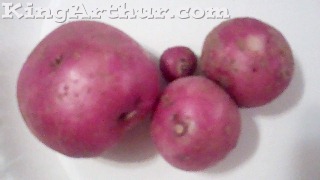 Solanine. The best way to minimize solanine is to grow your own crops.
Normally green is good to eat, but not in this case. Solanine is found in the potato,
tomato and eggplant.
Solanine. The best way to minimize solanine is to grow your own crops.
Normally green is good to eat, but not in this case. Solanine is found in the potato,
tomato and eggplant.
Solanine is a nerve toxin produced in the green part of the potato. It can occur naturally in any part of the plant, including the leaves, fruit, tubers and any green part of the skin. It is a bitter, poisonous, crystalline alkaloid that is part of the plant's defenses against insects. Potato leaves and stems are naturally high in glycoalkaloids. Avoid ingestion of these parts of the plant at all costs. Minimize the level of solanine in the potato skin by harvesting as soon as possible. The amount of solanine in the skin increases as the plant matures and eyes develop to reproduce.
Symptoms From Wikipedia
Solanine poisoning is primarily displayed by gastrointestinal and neurological disorders. Symptoms include nausea, diarrhea, vomiting, stomach cramps, burning of the throat, cardiac dysrhythmia, nightmare, headache and dizziness. In more severe cases, hallucinations, loss of sensation, paralysis, fever, jaundice, dilated pupils, hypothermia and death have been reported.Ingestion of solanine in moderate amounts can cause death. One study suggests that doses of 2 to 5 mg/kg of body weight can cause toxic symptoms, and doses of 3 to 6 mg/kg of body weight can be fatal.
Symptoms usually occur 8 to 12 hours after ingestion, but may occur as rapidly as 30 minutes after eating high-solanine foods.
Cucumbers are part of the Cucurbit family, along with squash and melons. These plants naturally produce chemicals called cucurbitacins, which are very bitter, and in large quantities can make a person ill. They are most often found in the leaves and stems, but also can be found in the green skin.